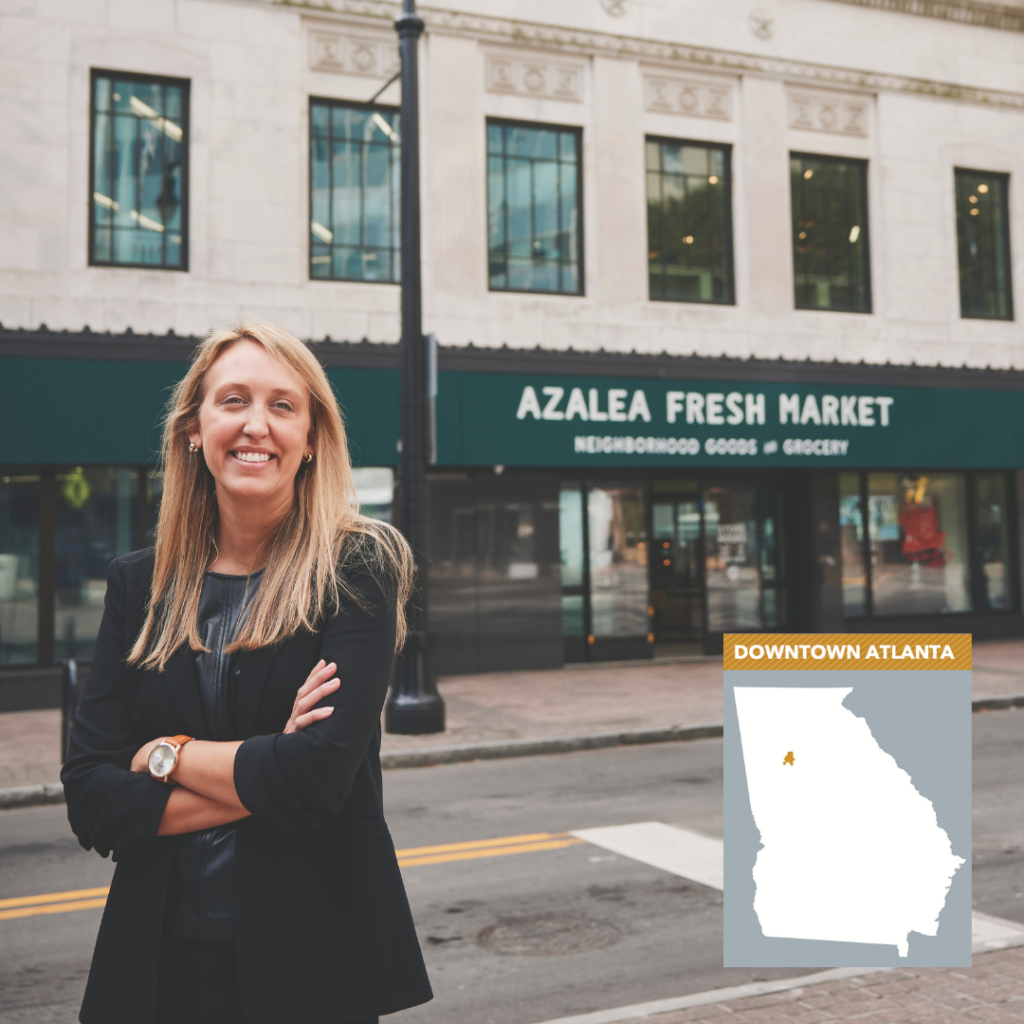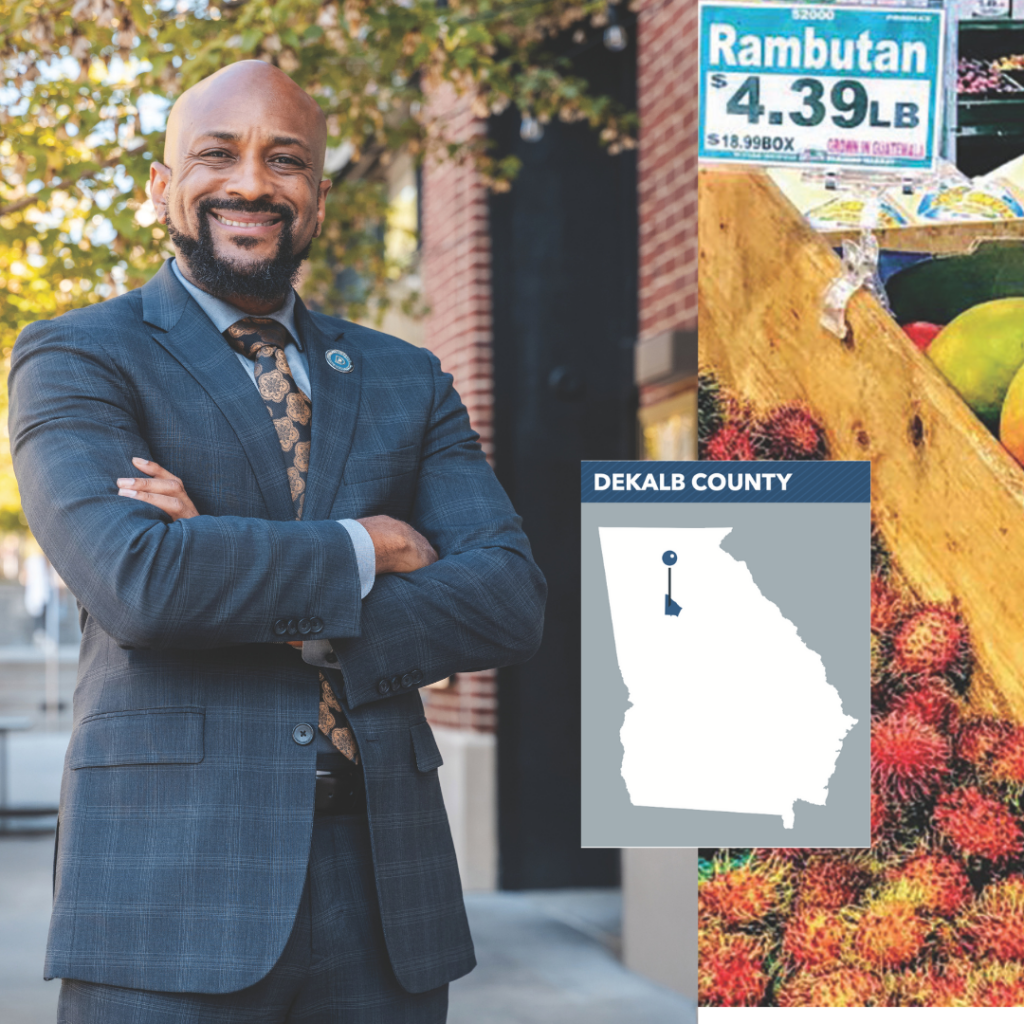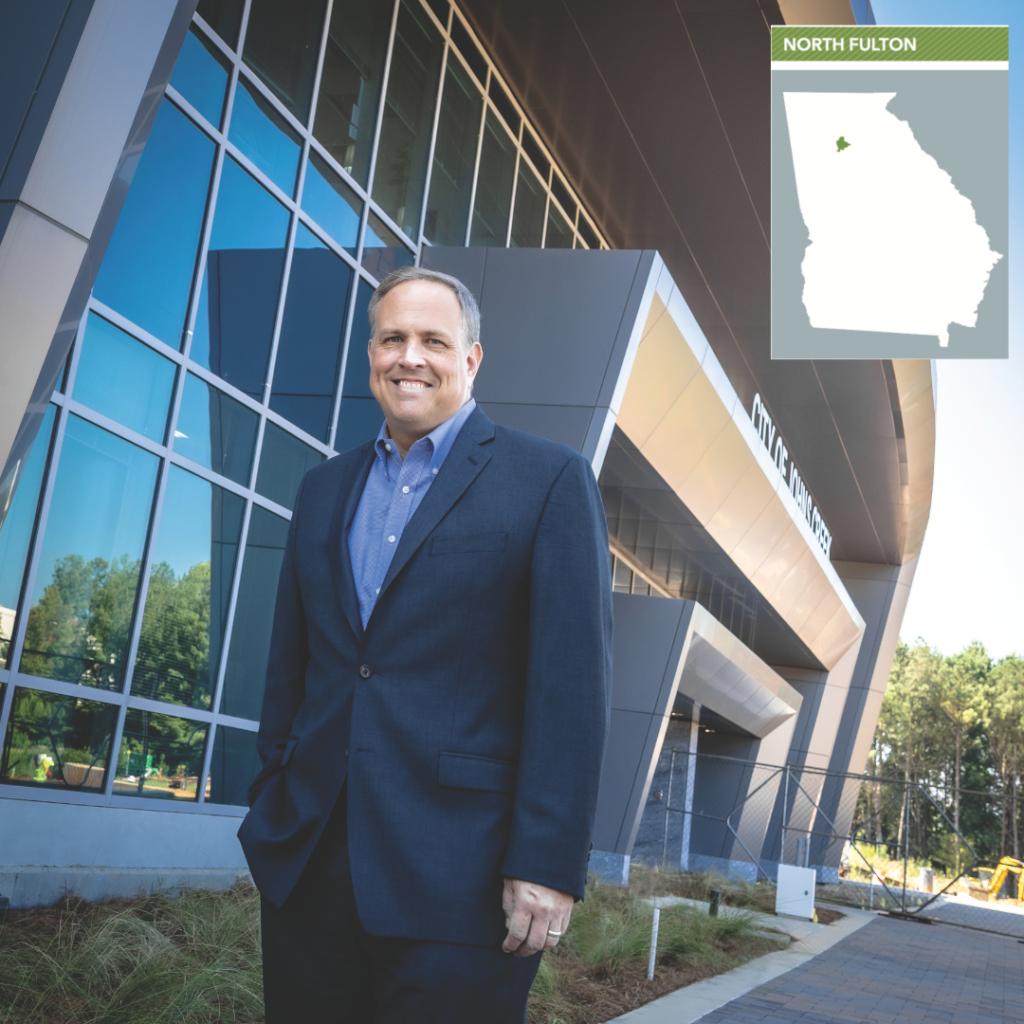Growing With Intention
Business, Development, Livability
North Fulton is a region that thrives from the uniqueness of its cities. Municipal and business leaders are proud of recent progress, but they recognize the need for paced growth – deliberate investments in economic, workforce or community initiatives that fit their city’s distinct population, needs and constraints.
“These cities are not cookie cutter. Everyone has their own specific success stories and their own specific challenges,” says Kali Boatright, president and CEO of the Greater North Fulton Chamber of Commerce. “For us, it’s embracing those and really knowing what nuance to use in each city.”
Playing upon each city’s strength to present a multifaceted but cohesive brand is the mission of the recently formed North Fulton Economic Alliance, a chamber initiative to market North Fulton as a single region composed of cities that complement one another. Executive Director Rich Johnson says the strategic initiative, budgeted for $300,000 over five years, will significantly support interconnectivity between the cities and address three priorities: improving the region’s competitive position for investment; expanding the talent pipeline by upskilling and retaining existing local talent while attracting skilled resources from outside the region; and establishing a united front to vie for resources together.
Johns Creek: Most Livable

Civic Hub: Rendering of Boardwalk at Town Center, which will include an amphitheater, pedestrian plaza and boardwalk connecting amenities, and be a gathering place for community events. Photo credit: Contributed
The city of Johns Creek has already proposed a $25,000 investment towards the branding initiative, according to Mayor John Bradberry. This would help Johns Creek maintain its record of marketability, as it has already been ranked No.1 Best Place to Live by U.S. News & World Report. The factors considered in the ranking include crime rate, cost of living, job market, net migration, climate, quality of education and more.
“It’s exciting, but it’s also daunting,” Bradberry says of the accolade, noting that he won’t rest on those laurels. “The key is to not become complacent or satisfied. I’m very focused on how we continue to deliver value and improve quality of life.”
Part of his strategy is the town center revitalization. Bradberry says the 43-acre mixed-use Medley development in Johns Creek Town Center is under construction by the Toro Development Company, the same firm that designed Atlantic Station and Avalon. By next summer, pharmaceutical company Boehringer Ingelheim will shift its U.S. animal health headquarters to a leased office space of 73,000 square feet at the town center to accommodate nearly 500 employees. The Medley mixed-use space is scheduled to open in October 2026. Bradberry says the development will be half as big as Avalon, but deliver similar white-glove concierge services, luxury retailers and upscale restaurants.

Success Story: Kali Boatright, president and CEO of the Greater North Fulton Chamber of Commerce. Photo credit: Kevin Garrett
The city is also constructing a new project behind city hall called Boardwalk at Town Center, which Bradberry says will serve as a civic hub to host parades, festivals and other community events. It will include an amphitheater, pedestrian plaza and a boardwalk that connects the parks amenities.
“We were very conscious to try [not] to make our town center too big because the goal is not necessarily for this to be a regional center. It’s really to serve the needs of the Johns Creek community. We tried to be very deliberate in planning something that would be unique and to scale,” he says.
That’s also why the City Council is leaving the decision to construct a performing arts center in the hands of residents. In November, residents will vote on a $40 million bond referendum to fund the construction of a $60 million facility that will house a proposed 800-seat auditorium and multipurpose room. The remaining $20 million is expected to be covered by the city without affecting its cash reserve, according to Bradberry. If passed, the bonds for the center would cost the average homeowner approximately $80 a year.

Upscale Development: Rendering of the 43-acre mixed-use Medley development, which will include high-end retail and restaurants. Photo credit: Contributed
“I felt that ultimately, it’s up to the residents of Johns Creek to decide,” Bradberry says, adding that Johns Creek is one of the most ethnically diverse cities in Georgia, with a large foreign-born population. Bradberry says the city has been looking into adding a performing arts center for more than 10 years.
Beyond funding amenities to improve quality of life for residents, he now aims to focus on improving the caliber of customer service delivered to residents and businesses interacting with city government.
“My goal is for us to be the best local government in the country, the most efficient, effective, transparent and accountable. We’ve got to keep striving or else we’re going to start moving backwards,” he says.
Milton: At Your Service
For a case study, Bradberry could look westward towards Milton, a city that ranked No. 1 for government employee customer service, according to the 2024 National Community Survey. Milton Public Works Director Sara Leaders says every redevelopment effort starts by first asking residents what distinguishes Milton from other places and what they envision for their community.

Vibrant Destination: Duplex housing in the South Highway 9 District, part of Milton’s chief commercial hub. Photo credit: Contributed
After extensive public engagement and collaboration with key stakeholders, the city planned the Deerfield/Highway 9 area and the District at Mayfield.
“In the coming months, we’re excited to see elements of both these plans come to life to foster vibrant, successful, pedestrian-friendly and uniquely Milton commercial hubs,” she says. The city’s primary focus is to transform Deerfield – spanning Highway 9, Morris Road, Windward Parkway and Deerfield Parkway – into a vibrant destination. Community members requested more landscaping, sidewalk improvements and interconnected streets.
The District at Mayfield comprises 23 parcels over almost 19 acres in Milton’s Crabapple area, including properties off Broadwell Road, Charlotte Drive, Mayfield Road and Mid Broadwell Road. Special Projects Director Bob Buscemi says residents and the council have shown interest in having more restaurants and retail.

Ebenezer Methodist Church’s new 23,000 square-foot activity center can host gatherings of up to 300 people. Photo credit: Contributed
“Mayfield is expected to be an extension of Milton’s downtown with a village-like, walkable, small-town feel with open space and a mix of lower-scale [one-to two-story] commercial and residential buildings in keeping with Milton’s character,” says Buscemi.
Additionally, the City Council has approved a hamlet overlay plan to guide development for Arnold Mill, a community-driven concept for a section of southwestern Milton that will include two commercial “activity nodes” along a corridor that will still maintain Milton’s unique rural charm, Leaders says.
The plan, approved in May, identifies two new projects: a country inn with 16 cottages near the historic McConnell-Chadwick House, Little River and Cherokee County line and a park or mixed-use space close to the intersection of Arnold Mill and Cox Road.
Sandy Springs: Culture and Cuisine
Streamlining travel corridors while retaining sense of place is a priority in Sandy Springs as well, according to Economic Development Director Chris Burnett.

Housing and Entertainment Needs: Sandy Springs Economic Development Director Chris Burnett. Photo credit: Kevin Garrett
Sandy Springs aims to create three east-west passages in and out of its downtown to the Perimeter office market. The first is the Johnson Ferry/Mount Vernon Highway project to transform a “confusing” stretch of Mt. Vernon that only went eastbound and a stretch of Johnson Ferry that only went westbound. Now, both roads will extend east-west, Burnett says. The second project – completed a few years ago – expanded Abernathy Road to four lanes in both directions. Finally, a third initiative will reconfigure the last section of Hammond Drive between Roswell Road and Glenridge Drive.
Sandy Springs is also investing in a pathway to improve pedestrian and cyclist connectivity to the downtown, similar to the Beltline. However, Burnett says the city is phasing the upgrades so as to not clog Sandy Springs with construction, particularly since its City Springs area is already swarming with activity. Now in its 20th year of cityhood, Sandy Springs is flourishing with arts, culture and restaurants.
Dining options will continue to expand with Hillcrest, an 8-acre mixed-use development that broke ground in June and is expected to be complete in 2027. Developer High Street Residential, the residential subsidiary of Trammell Crow, alongside partner Third & Urban, has plans to include 362 apartment units, 30 rental townhomes, approximately 18,000 square feet of retail space and a central green space. Once its parking structure is built, Trammell Crow will receive a 10-year tax abatement for designating 111 parking spaces for City Springs patrons to use.

Coming in 2027: Rendering of Hillcrest, an 8-acre mixed-use development that broke ground in June. Photo credit: Contributed
Burnett says the city has to meet the housing and entertainment needs of two key demographics: retirees who wish to age in place and young professionals. In the buzzing entertainment and dining spaces of its urban downtown, Burnett witnesses the eclectic tastes of this blend of customers.
“The diversity of age is really wonderful to see. You’ll see 20-somethings hanging out with their friends and sitting next to them waiting to get into the restaurant … will be grandma and grandpa with their kids and their young grandchildren,” Burnett notes. “That really is the heart and soul of our city.”
Alpharetta: Repurposed Spaces

Brookside Village, which aims to repurpose a 1980s-era office park into a mixed-use development. Photo credit: Brookside Village from Portman
Expanding housing options is a bit more complicated in Alpharetta, one of Atlanta’s smallest suburbs covering just 27 square miles. City officials have had to get creative to repurpose land into mixed-use developments that can accommodate more residents. Roughly 87,000 employees commute into the city to work at its innovative tech firms.
The repurposing of Brookside Office Park is a prime example. Portman Holdings is expected to transform the business complex built in the 1980s, adding 335 multifamily units, 70 townhomes and 60,000 square feet of commercial and retail space.
Meanwhile, the Alpha Loop, a multiuse trail project that connects various places around the community is nearly complete. Phase 1 connected downtown Alpharetta to Avalon, and Phase 2 connects the Chelsea Walk and Atley neighborhoods with the Maxwell mixed-use district. The last step will be to connect the second phase northward across Old Milton Parkway to the first phase at Thompson Street.

Connecting and Modernizing: The Alpha Loop is a multiuse trail project that is nearly complete. Photo credit: Alpharetta Convention & Visitors Bureau
“Part of the reason why companies are successful here is because of the amenities the city of Alpharetta offers,” says Mayor Jim Gilvin.
The city is developing a framework to reimagine the North Point area as a mixed-use development with ample green space around a network of streets, trails, parks and green infrastructure. The mall space will be revitalized and potentially anchored by a sporting arena as the Alpharetta Sports & Entertainment Group has been trying to woo a National Hockey League team back to Metro Atlanta. This proposal faces competition from The Gathering at South Forsyth, another development about five miles north that’s also planning to build a hockey arena in the hopes of bringing an NHL franchise back to Metro Atlanta. The NHL’s Atlanta Flames relocated to Calgary in 1980, and the Thrashers left in 2011.
Roswell: Booming Businesses
The city of Roswell is also eyeing sports- centered mixed-use spaces similar to The Battery in Cobb County, according to Mayor Kurt Wilson. Last year, the City Council approved a letter of intent between Roswell and the United Soccer League to develop an entertainment district anchored around a soccer stadium. If it materializes, the stadium would host a professional women’s soccer team as well as a USL Championship professional men’s team.
In the last year, Roswell opened two mixed-use spaces that are faring well. Food hall Roswell Junction is open and home to seven food stalls. And at Southern Post, retail space is 90% full, office space is 75% occupied and all apartments have been leased with an eight-month wait list, according to Wilson.
The Southern Post project was named commercial development of the year for Atlanta in the 2025 CoStar Impact Awards. It also received a gold award for real estate development and reuse by the International Economic Development Council, a nonprofit, nonpartisan membership organization serving economic developers. This same council also gave Roswell Inc. a bronze award in the category of Economic Development Organization of the Year. Roswell Inc. is an accredited public-private economic development partner of the city of Roswell.
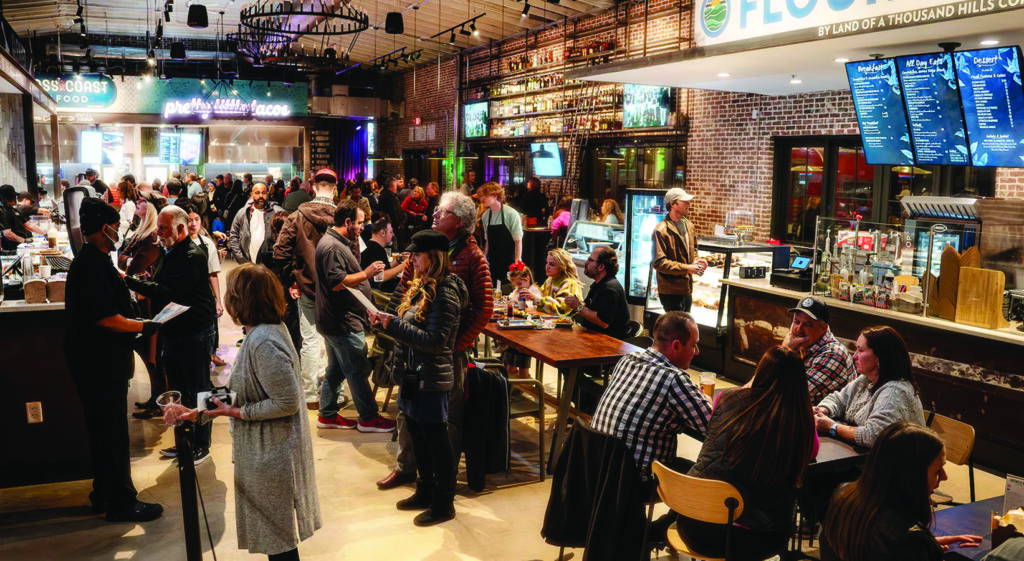
Busy Venue: Roswell Junction is a 12,000-square-foot food hall and entertainment complex, featuring food stalls, bars, arcade games, a stage and outdoor spaces. Photo credit: Contributed
Steve Stroud, president and CEO of Roswell Inc., says the peer recognition grants Roswell Inc. greater credibility with businesses, site selectors and investors.
“Fourteen years ago, we started with a bold vision for our city’s economic future. To now be recognized with four international awards – more than any other economic development organization in the state – is a milestone that speaks volumes. This achievement isn’t just about our small but mighty staff of five; it’s a reflection of the thriving economic ecosystem we’ve built in partnership with the city of Roswell,” Stroud wrote in an email. “This hard-earned recognition will build confidence among our existing businesses and attract new investment, proving that our city is a premier destination for business.”
Roswell Inc.’s role in diversifying mixed-use spaces has been essential for catering to the needs of new talent and businesses that the city is attracting.
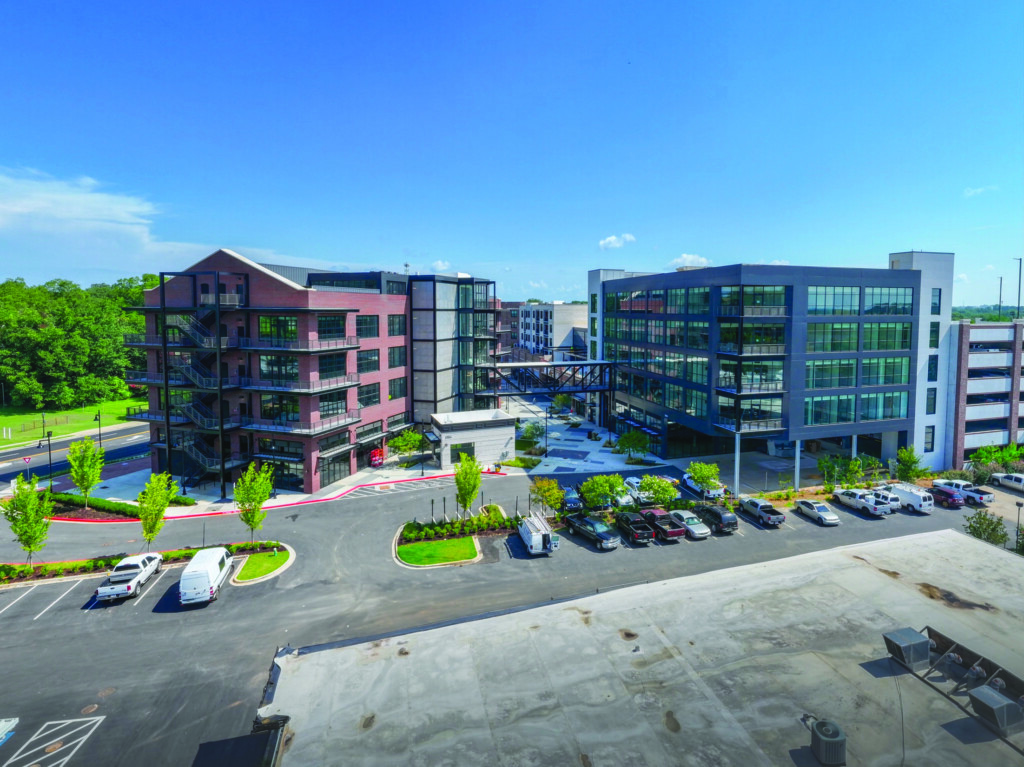
Award-Winning Development: Southern Post, which contains residential, retail and office space, has been recognized for its real estate development and reuse. Photo credit: Contributed
In February, city officials announced that Czech-based turbojet manufacturing company PBS Aerospace chose Roswell for its North American headquarters, manufacturing and R&D operations. The company, which opened in September, is investing up to $20 million in the facility to produce small jet engines used in high-speed drones and missile systems. It has hired about 45 employees so far and plans add up to 100 more over the next five years. The average annual salary is estimated at $150,000 a year for roles ranging from aerospace engineers and quality assurance techs to business development, finance, legal and even directors of supply chain and production, according to Wilson.

Bringing Jobs: Roswell Mayor Kurt Wilson, far right, attends the ribbon cutting for the grand opening of PBS Aerospace North America in September. Photo credit: Contributed
Furthermore, in April, Gov. Brian Kemp announced CRH, leading provider of building materials solutions, is setting up its finance and accounting shared services hub in Roswell, investing $1.7 million and creating more than 300 new jobs in Metro Atlanta. Hiring was already underway when the announcement was made, with full staffing to be reached by 2029.
With all of this rapid growth, Wilson is realistic about the impact on traffic and congestion. His advice to residents is to slow down and think of Roswell’s historic streets and parks as a destination rather than a commute.
“I’m going to slow you down [in] my city neighborhoods. We have committed $35 million for a pedestrian plan. We are serious about adding to modalities other than cars,” Wilson says. The intent is not only to make Roswell streets safer, but to encourage passers-by to stay awhile.
Local Flavor
Peek into the Past

Community Pride: Judy Meer, former president of the Roswell Historical Society. Photo credit: Kevin Garrett
Most everyone is familiar with Jimmy Carter’s childhood in Plains, and many know of Franklin Delano Roosevelt’s Little White House in Warm Springs. But you might not know that the mother of Theodore Roosevelt, Martha “Mittie” Bulloch’s childhood home was Bulloch Hall, in downtown Roswell.
Visitors to North Fulton can now travel back in time at the Roswell History Museum and learn about all the different presidents who had links to the area – at a rotating exhibit called Presidential Connections to Roswell. The exhibit is just one among countless other interesting artifacts at the museum.
Since 1971, the Roswell Historical Society, founded by a dedicated group of Roswell residents, has meticulously recorded the city’s heritage, with the mission to collect, preserve, share and promote the history of the city and its people. Its Research Library and Archives, along with the Smith Plantation, Barrington Hall and Bulloch Hall, are now part of Roswell’s historic house museum system.
“The society and museum are central to Roswell’s identity as a city with deep Southern roots and preserved antebellum charm,” former society President Judy Meer says. “This tangible connection to the past enhances tourism and enriches Roswell’s sense of place and community pride.”
The museum has original photographs, documents and artifacts covering key events in Roswell’s history, from the establishment of the Roswell Manufacturing Company (circa 1839) by founder Roswell King to the Civil War occupation of Roswell by Union troops and the deportation of approximately 400 mill workers.
The museum includes Black history, from enslavement to the establishment of thriving post-war communities like Zion Missionary and Pleasant Hill Baptist Church, and chronicles the transformation of Roswell from a mill village to a modern suburb. The museum’s most prized collections, in Meer’s view, are original land deeds signed by Roswell King, Civil War correspondence from local families and rare photographs of 19th-century Roswell landmarks.
“These items provide personal, unfiltered glimpses into life during pivotal periods of Roswell’s development,” Meer says.
She encourages people to visit the museum, at the Roswell Cultural Arts building, where residents can scour architectural survey files containing detailed research on many of Roswell’s antebellum homes, including blueprints, restoration notes and family histories.
Balancing preservation needs with limited funding is challenging. Meer is keen to engage younger members as they can volunteer by leading tours, assisting in event planning or contributing to research projects.



